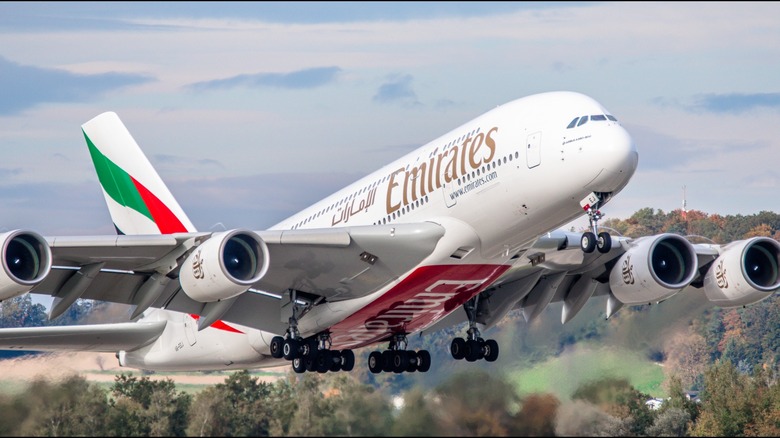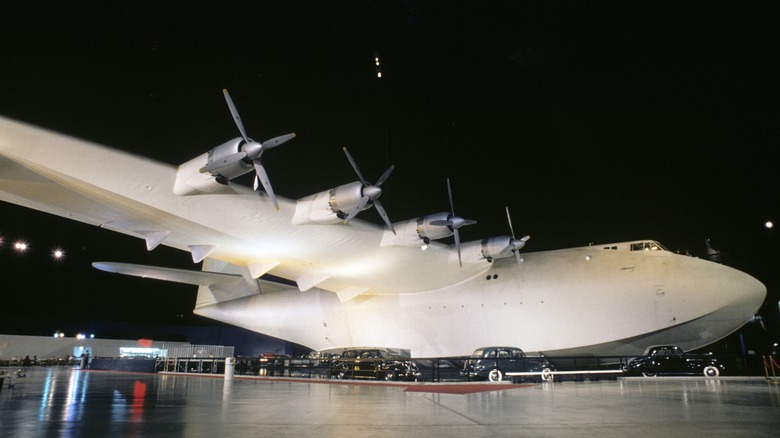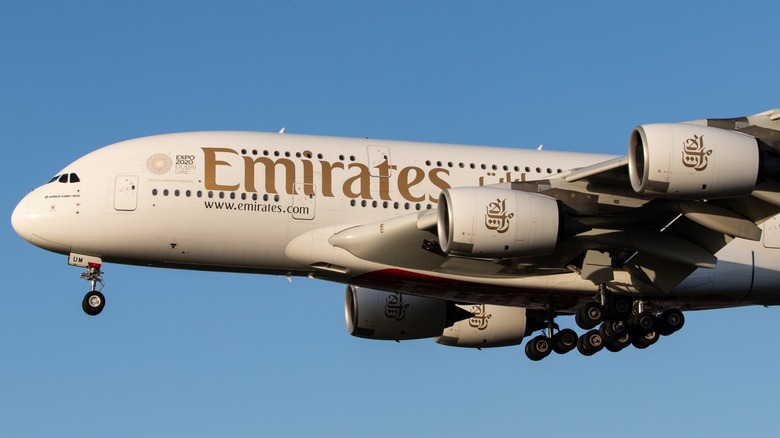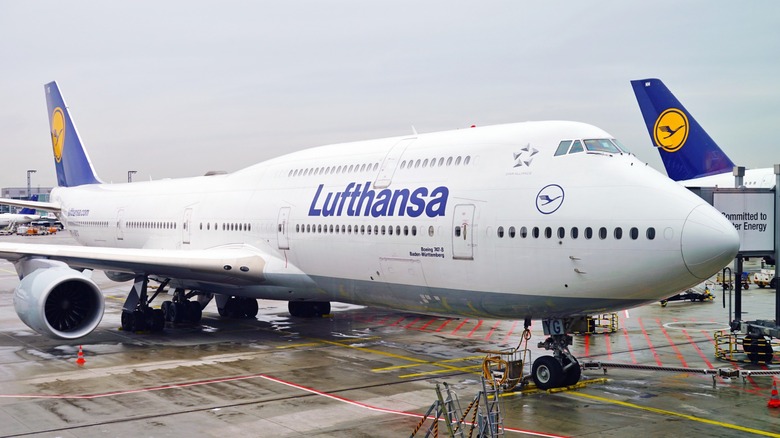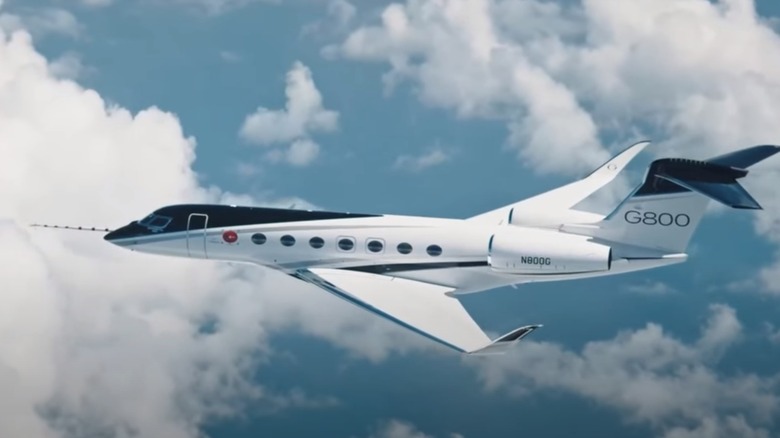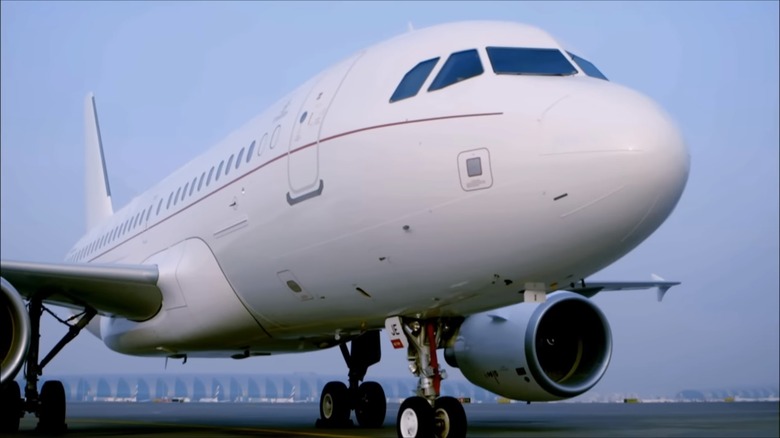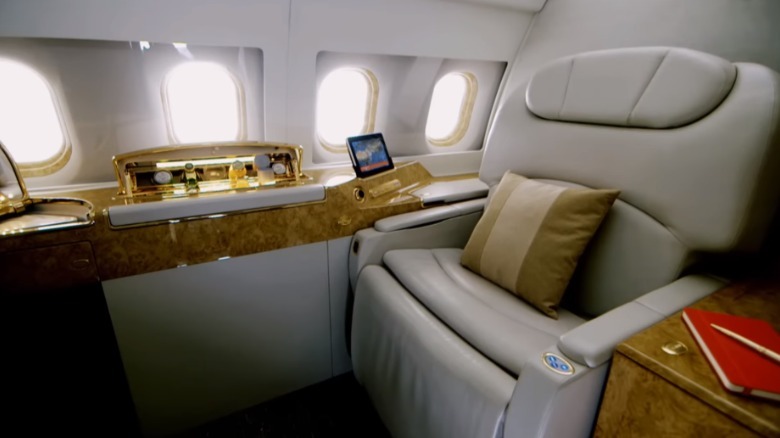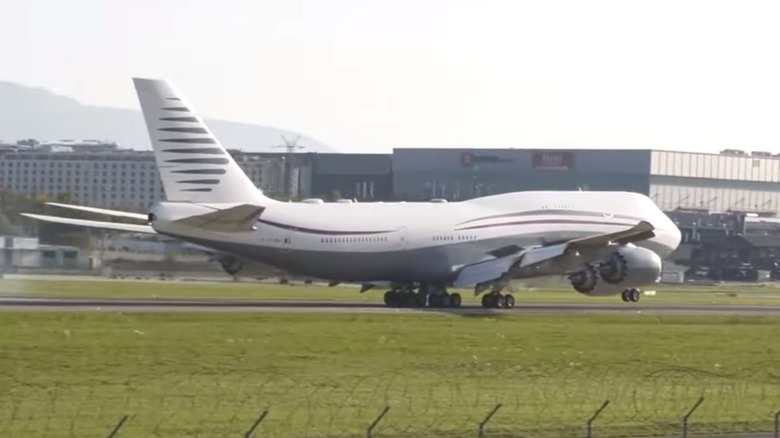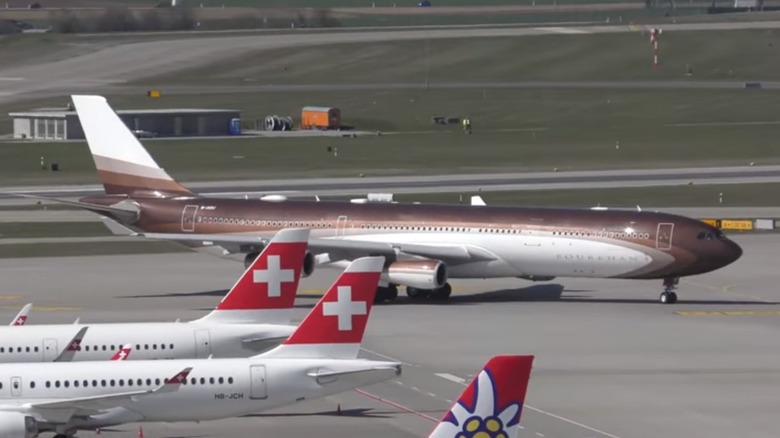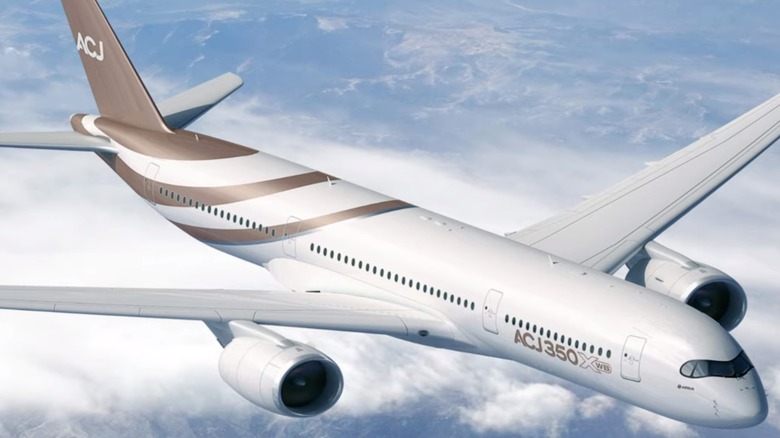8 Of The Most Expensive Commercial Passenger Jets Ever Built
The airplane is one of the wonders of the modern world, and while you may not often think about it, aviation has shaped our world and way of life in innumerable ways. On the scale of all human history, the time that man has been able to reach through the clouds is but a sliver of a moment. Yet the advancement of the technology has happened at breakneck speed and achieved impressive results, providing us with some of the most sophisticated and complex machinery imaginable. However, it all comes at a cost.
Anything connected to aviation comes with a significant price tag. Whether it is a radio, an engine, or an entire fuselage, a lot of money goes into making an aircraft and getting it into the air safely. The high cost of aircraft construction comes from raw materials, advanced electronics, and low-volume manufacture. And since aircraft must be built to within extremely tight tolerances, with redundant systems for greater safety, further costs are incurred. The end result of this is extraordinarily expensive airplanes that few people have the means to purchase, although some cost more than others. While the most expensive aircraft made today are reserved for the military and national defense, here are some of the most expensive commercial passenger jets.
Hughes H-4 Hercules -- $23 million (1947)
Built as a project from personal obsession, Howard Hughes' H-4 Hercules aircraft set a record for having the largest wingspan of an airworthy aircraft; the record stood until 2019. The aircraft, dubbed "The Spruce Goose" by mocking journalists of the day, was built by Hughes Aviation and only took flight once, in 1947.
The H-4 design stemmed from the need for a transatlantic air freighter that could delivacer significant payloads and avoid the losses incurred from German U-boats in the Atlantic. Seeking to secure a government contract for a new massive flying boat with enormous payload capacity, Hughes commissioned what would eventually become the H-4 Hercules. Although he was able to get one built, it came too late as the war ended before it could be completed.
Its nickname was meant to ridicule the project for the significant quantities of timber used in its construction at a time when most aircraft production had switched to using steel and aluminum. Regardless, the huge flying boat was built and featured eight 3,000-horsepower engines, four to a wing. Hughes himself took the controls for its inaugural flight, proving that it could fly, although it would also be its final flight. Today it is preserved at a museum in Oregon. It cost Hughes $23 million to build, which is equivalent to $328 million today.
Airbus A380 -- $445 million (2008)
Throughout the latter part of the 20th century, aircraft manufacturers built increasingly larger airliners to fly ever more passengers on long-haul flights. One of the earliest of these giants was the Boeing 747 in 1969, featuring two decks with passenger seating and a huge cargo hold. It ruled the skies for years until Airbus sought to outdo Boeing with its massive A380, first flying in 2005.
As a company jointly owned by French, German, Spanish, and British interests, Airbus is a truly European concern with global reach. Its successful aircraft designs, beginning with its 1974 A300, meant Airbus was well positioned to bring out a new product to ease congestion at the world's major airports. The idea was to introduce a plane with significantly increased capacity to fly fewer routes to international locations, allowing passengers to continue to final destinations on regional routes. With a maximum possible capacity of 853 passengers, it dwarfed the 660-passenger capacity of Boeing's 747 upon introduction.
Airbus delivered its first A380 in 2007 with much excitement for the new aircraft, expecting its success would lead to it becoming the world standard in international travel. However, despite a $25 billion investment, only 251 aircraft have been produced, with no plans for any more. The list price of an A380 is $445 million, but that is only the beginning of what it costs to keep one going. Sadly for Airbus, more fuel-efficient planes and changing trends in the industry found airlines opting for other aircraft to fill out their fleets.
Boeing 747-8 -- $418 million (2022)
While the Boeing 747 entered service in 1970 and has ferried countless passengers across all oceans, its story is far from over. In 2005, on the heels of the Airbus A380 introduction, Boeing announced a plan for a revised and enlarged version of its flagship 747 aircraft. As the fourth generation of the 747, the new 747-8 would offer a lengthened fuselage, new wing design, and higher efficiency. However, even though this would increase the efficiency and capability of the 747 model, it would be Boeing's last iteration of the jumbo jet.
Flying in most 747-8 aircraft offers you a choice of first class up front and below the cockpit with business and economy to the rear, as well as additional business seating located on the upper deck behind the pilots. The additional fuselage length over the 747-400 preceding this aircraft also provides substantially more space for cargo on the air freighter variants. However, despite the many upgrades and added benefits of the revised giant, as early as 2013, Boeing cut production due to diminished demand. More production cuts were announced in 2017, and in 2022, production ended completely. Only 155 were produced, perhaps indicating that trends had changed, and the new variant had failed to meet the needs of today's airlines. Additionally, its $418 million list price, paired with extraordinarily high operating costs, made it a tricky investment to ensure positive returns over the life of the aircraft.
Gulfstream G800
For the finest in private and corporate executive travel, the Gulfstream name is well known, and synonymous with quality and luxury. For those who need private air service with long-range capabilities, the range-topping Gulfstream G800 is one of very few options in the category. With a range of 8,000 nautical miles at Mach 0.85, executives can arrive at their destinations quickly but with the added benefit of having a serene flying experience while on board.
With a maximum passenger capacity of 19 passengers — configurations with more space for fewer passengers are also available — the G800 is larger than many competing executive jets. Furthermore, with its maiden flight taking place in 2022, it is one of the newest jets on the market. Filling out the cabin of this jet are the finest and most sophisticated systems and the most luxurious interior appointments. Hand-crafted seats, high-definition lighting, plasma-ionization air purification, and the largest windows in the industry top the lengthy list of premium features from cockpit to tail.
New aerodynamic wings, coupled with Rolls-Royce high-thrust engines, raise the efficiency of the G800 to new levels for a jet of this class, but the highlights for its owners will be, as always, the exceptional attention to detail and unmatched luxury of an exquisite private jet. Those owners are likely to be less sensitive to the efficiency gains and lower operating costs, as the price of entry runs about $72 million, making it one of the most expensive private jets on the market today.
Emirates Airbus ACJ319 Executive Jet -- $107 million (2023)
The European aerospace firm Airbus has been producing its popular A320 narrow-body passenger jet since 1987, spawning several variants in the ensuing years. A version with a shortened fuselage and decreased capacity debuted in 1997, which was later adapted to make the ACJ319 version for private corporate travel. With the reduced size of the fuselage and configuration for corporate travel, the capacity of the business jet can be configured for anywhere between 19 and 50 passengers.
With a current list price of about $107 million for the most recent ACJ319neo and annual operating costs of up to $3.2 million, only the exceedingly wealthy can have one of these for themselves. However, thanks to Emirates, you and anyone you know can charter one for yourself and experience the lap of luxury at 30,000 feet. With the Emirates SCJ319, you can fly up to 19 passengers — or up to 15 passengers in a configuration for sleeping — for journeys of up to eight hours in spacious and private suites. You will be treated to exclusive service in lush surroundings with features such as Wi-Fi, 32" video screens offering 1,600 channels, video games, movies, and music. Furthermore, executive dining service is available, and those who need to freshen up can hit the shower spa. While in flight, guests can assemble in either the lounge or business suite for work or play, depending on what sort of group is on board. While all of this may sound tempting, the cost is exorbitant at $15,000 to $20,000 per hour.
Boeing BBJ747-8i - $500 million (2015)
Anyone familiar with the Boeing 747 jumbo jet and the revised 747-8 will know that either one is an extraordinarily expensive aircraft. Although one can be configured with a single class of seats to a maximum capacity of 605 passengers, Boeing offered this aircraft with accommodations for a much smaller crowd.
Boeing Business Jets is the division of the company that markets aircraft for private and corporate customers. To serve its wealthiest clients, it offered the Boeing BBJ-747-8i as one of the largest private aircraft ever made, and it fulfilled several orders before retiring the 747 altogether in 2023. With a passenger count of just 100, the BBJ747-8i takes excess and largesse to the extreme.
An aircraft owned by the Qatari Royal Family went up for sale in 2020, giving a glimpse of the sort of opulence one can expect when boarding such a plane. It had five galleys, two private en suite bathrooms, master bedroom, grand central staircase, and a large business lounge. It was configured to hold only 89 passengers, with free reign to roam the cabin surrounded by opulence unimaginable to most people. This followed another BBJ-747-8i that was listed for sale in 2018. It was similarly equipped but only configured for 76 passengers. Prices for those sales were not published; however, the BBC reported in 2018 that the Qatari family gifted one of its private jumbo jets to the President of Turkey, noting its value of $500 million.
Airbus A340-300 -- $425m (2012)
Airbus released its A340 narrow-body airliner in 1982 in two variants, the shorter A340-200 and the longer A340-300. This product, capable of carrying up to 290 passengers, has proven itself as a successful part of the Airbus family of planes. Powered by four CFM turbofan engines, the A340 is capable of ultra-long-haul flights and has been a favorite among international carriers since its introduction.
Originally from Uzbekistan in the Soviet Union and rising first through Soviet bureaucracy before hitting his stride in the tumultuous era of post-Soviet Russia, Alisher Usmanov became one of the wealthiest individuals on the planet. With billions in wealth derived from holdings in Russian mining and telecommunications, Usmanov can buy pretty much whatever he wants. In 2012, that was an Airbus A340-300 aircraft. Haute Living reported at the time that he acquired the aircraft for $250 million. However, that was just the purchase price, and converting it into a private jet would be an extensive investment. The interior is lavishly decorated with plush seating, premium materials, and spaces for work, such as a conference table. Additionally, the oligarch splurged for an advanced and sophisticated anti-terrorist security system and a "panic room" capable of supporting 11 people for five days in the event of a crash.
Usmanov is currently on the list of sanctioned oligarchs, resulting from Russia's invasion of Ukraine. The Airbus is among the assets targeted for seizure, and the U.S. Department of the Treasury, tasked with imposing the sanctions, estimates its value at between $350 million and $500 million.
Airbus ACJ350 XWB
Well-known for its range of commercial airliners flying millions of people around the world every day, aerospace manufacturer Airbus also markets its aircraft to corporate and private customers. Unlike an airline, which must maximize profits by flying the most passengers feasibly on any given flight, the corporate buyer's needs are substantially different. For them, minimizing travel time and ensuring the best possible comfort and rest between appointments are the prime considerations. Therefore, Airbus offers several aircraft in several configurations accommodating only a fraction of the passengers of an airliner.
The largest and most expensive Airbus Corporate Jet is its ACJ350 XWB. This is the private aviation version of the wide-body A350 intercontinental airliner. While the airliner version of this aircraft can accommodate nearly 500 passengers, the ACJ350 XWB is equipped for as few as 25, plus the crew. This exclusive group of flyers will have available to them comfortable oversized seating, a dining/conference room with a large table and lounge area with sofas, and for the very lucky ones at the top of the hierarchy, a private bedroom with an attached office and spacious bathroom. It is truly like an apartment/office in the sky.
With so much space for so few people, exclusivity is the overarching detail. That exclusivity comes, as it always does, for a price. This aircraft is currently offered by Airbus for $317 million, which means convincing the board to approve a purchase could be tough.
